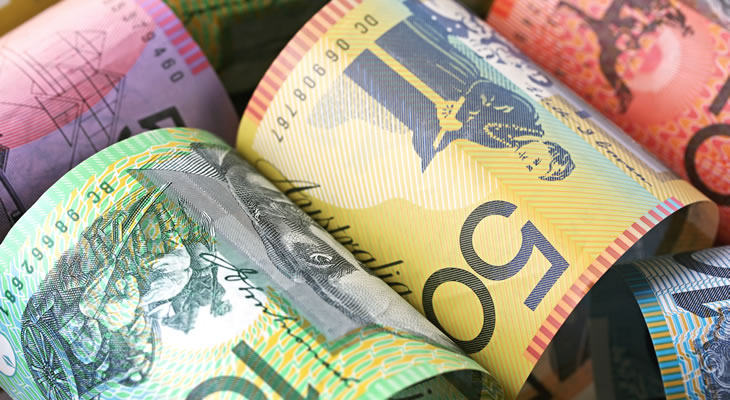- Pound AUD Exchange Rate Hovers Around 1.7550 – Drops after Friday’s PMIs
- UK Flash PMIs Indicate Economic Damage – Brexit looks to have impacted UK economy
- Australian Dollar Steady After Drops – Investors adjust bets on RBA rate cut
- Forecast: Australian Inflation in Focus – Wednesday’s CPI to be main indication of RBA action
Pound AUD Exchange Rate Plummets Further as ‘Aussie’ Strengthens
The Pound to Australian Dollar exchange rate hit a new weekly low of 1.7384 on Tuesday after a weak Sterling was easily advanced on by a surge in ‘Aussie’ appeal.
As the US Dollar weakened throughout the day on low Fed rate hike bets and less aggressive Bank of Japan (BoJ) stimulus bets, risky currencies like the Australian Dollar were able to easily capitalise.
The Pound was also undermined by news that a previously hawkish Bank of England (BoE) policymaker, Martin Weale, had seemingly shifted his stance after seeing Friday’s PMI results.
The dire UK ecostats were reportedly far worse than Weale had anticipated. While he previously adopted a ‘wait and see’ stance rather than opting for more rate cuts, he now joins other BoE policymakers playing up the possibility of action being taken in next week’s BoE meeting.
However, GBP/AUD could easily recover in Wednesday’s session if upcoming Australian inflation figures indicate that an RBA rate cut is likely.
(Published 11:08 BST 25/07/2016)
The Pound AUD exchange rate trended a little more flatly on Monday after last week’s heavy fluctuations, as investors awaited Wednesday’s key Australian Q2 inflation report. Sterling has remained weak since Friday’s flash PMIs indicated the extent of the Brexit vote’s economic damage.
GBP/AUD approached both July’s best levels and June’s worst levels last Friday, briefly hitting 1.7762 before Britain’s PMIs were released. The pair then lost almost two cents and has trended flatly in the region of 1.7580 since markets opened for a new week of trading.
Sterling (GBP) Sentiment Pressured Further as Brexit Fears Come True
The Pound plummeted across the board on Friday, losing much of its weekly gains due to news that the Brexit vote had had a definite negative effect on Britain’s economy in July.
While Sterling has continued its gradual recovery attempts despite all the pressure on it in the last month, this news heavily weighed on its advances, setting it back and worsening recession fears.
Friday’s flash PMIs for July undermined a previous Pound recovery rally. Manufacturing fell from 52.1 to 49.1, Services plummeted from 52.3 to 47.4, and the overall Composite score contracted at 47.7.
According to Markit Chief Economist Chris Williamson, these figures indicate that the UK’s economy could contract by 0.4% in Q3 if this sort of activity continues. He also indicated that this was the news bank policymakers would have needed in order to justify an interest rate cut;
‘With policymakers waiting to see hard data on the state of the economy before considering more stimulus, the slump in the PMI will provide a powerful argument for swift action.’
With the effects of the Brexit vote becoming clearer, investors are settling lower on the Pound, less eager to further its recovery.
However, investors took the currency slightly higher on Monday as they continued to purchase it from its low levels. News that Britain was seeking out a free trade deal with China also boosted Sterling’s appeal.
Australian Dollar (AUD) Flat as Investors Await Q2 Inflation News
Favour towards the recently bullish Australian Dollar faltered during last week’s session as investors reacted to the Reserve Bank of Australia’s (RBA) minutes from its July meeting.
With the August RBA meeting just over a week away, the RBA keeping the door open for a key interest rate cut throttled the ‘Aussie’ and is among the main reasons Sterling was able to gain on its rival last week.
Struggling prices of iron ore, Australia’s most lucrative commodity, also weighed on appetite towards the ‘Aussie’ Dollar.
Australia’s central bank cited deflation fears and the overly high value of the Australian Dollar as being among the reasons that an August rate cut was being considered.
However, investors remain optimistic as the Australian Dollar advanced from its lows on Monday, ahead of Wednesday’s highly anticipated inflation report.
Pound AUD Exchange Rate Forecast: Australian Inflation Report Ahead
Wednesday’s Asian session will see the release of Australia’s Q2 Consumer Price Index (CPI) report.
With low inflation (and deflation) cited as among the reasons for a potential Reserve Bank of Australia (RBA) interest rate cut, this upcoming report will be the single biggest indication of how likely a rate cut will be.
If Q2 inflation beats expectations, bets of an August rate cut will drop, and the Australian Dollar will soar.
Unfortunately, an overvalued ‘Aussie’ is amongst the RBA’s worries, meaning a rate cut would still be possible. It is because of this that any rally the ‘Aussie’ makes could be limited.
If inflation comes in below the predicted levels of around 0.4%, rate cut bets could increase, which may cause AUD to plummet.
The Pound, on the other hand, is likely to react to Wednesday’s flash Q2 growth report. Gross Domestic Product (GDP) is expected to see slight improvement from April through June, but some analysts have predicted that June Brexit jitters could drag growth for the quarter down.
Better-than-expected Q2 growth would increase hopes that the Britain’s economy was sturdy enough in the run up to the Referendum to soften some post-Brexit economic blows.
Lower-than-expected growth would instead cause investors to worry that Brexit jitters had a worse effect on the economy than forecast and would make Q3 and Q4 growth forecasts even more dire.
At the time of writing, the Pound AUD exchange rate trended in the region of 1.7550, while the AUD Pound exchange rate traded at levels around 0.5700.


Comments are closed.